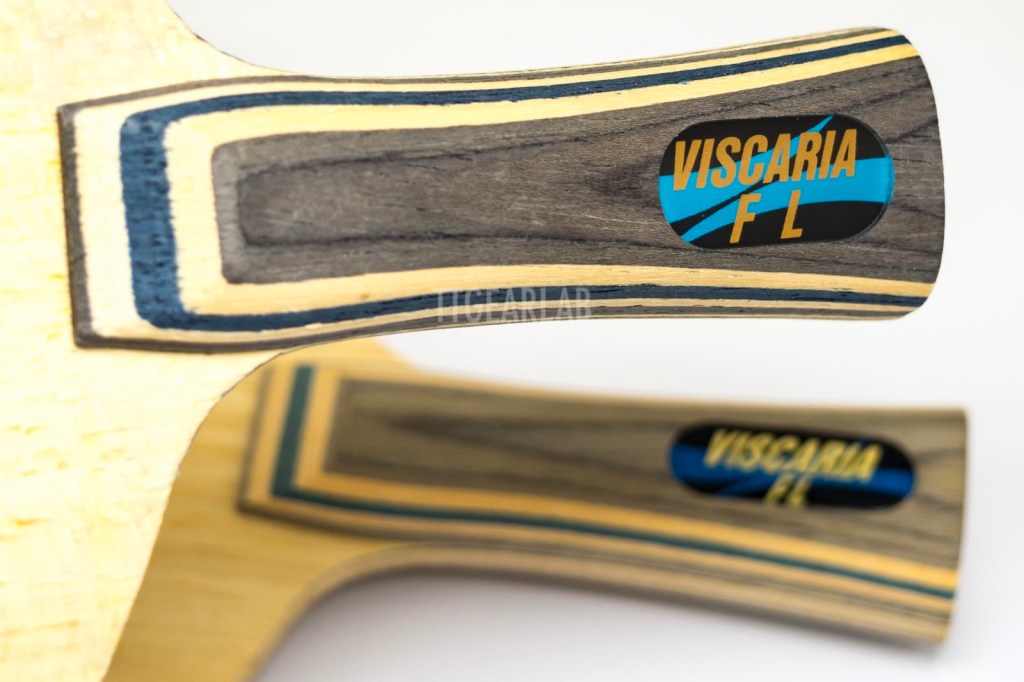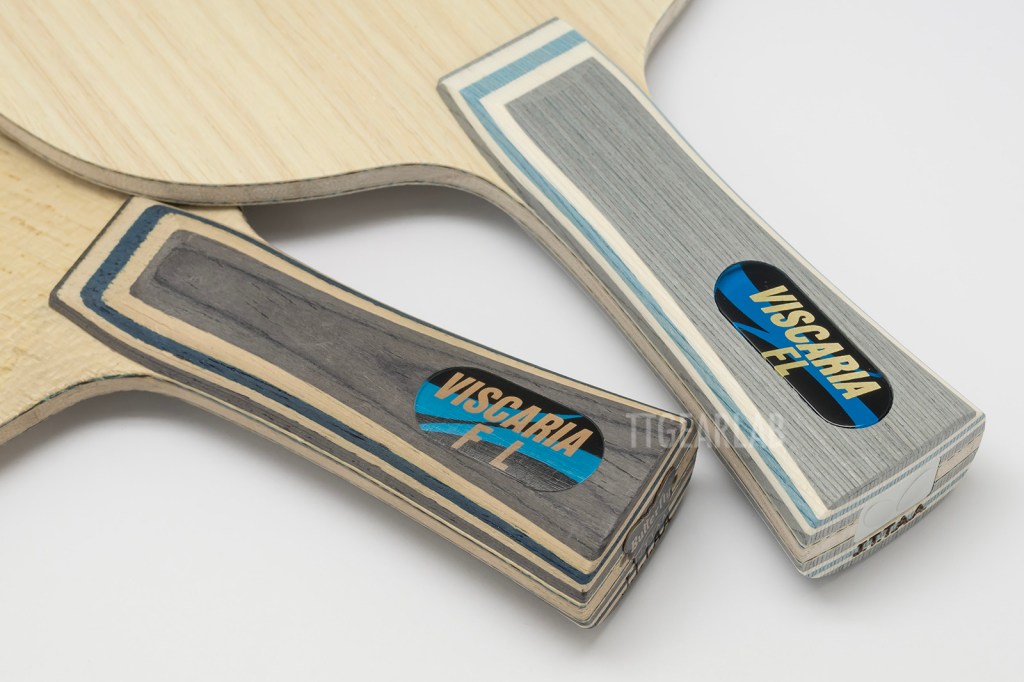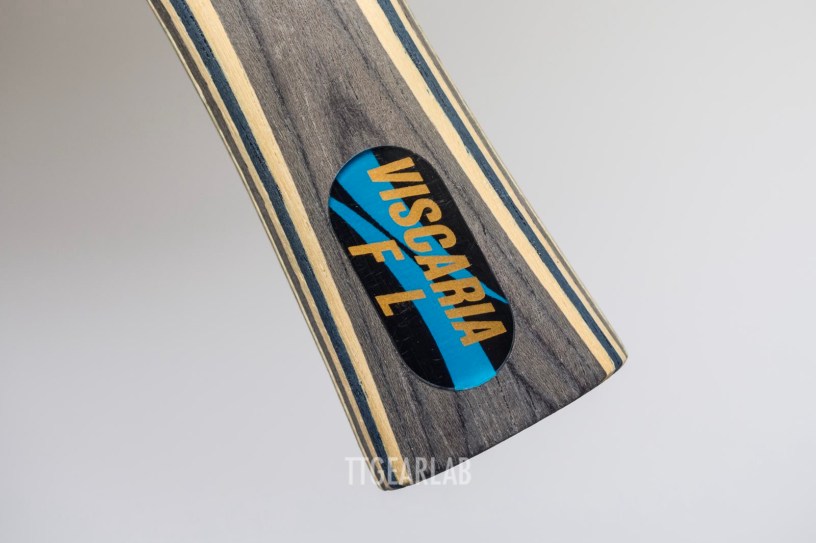Butterfly ‘Viscaria’ which is the best seller of Butterfly is the representative of the ‘outer-fiber’ blade. And, it is also the representative of all fiber blades. ‘Viscaria’ had been announced in late 1993 as the new fiber blade of model year 1994, and started to be sold on 21th November 1993. ‘Viscaria’ is a very important blade in the history of table tennis blade because it is the first blade for which composite material is used. Arylate Carbon (= ALC) which is first used for ‘Viscaria’ is currently dealt as the standard material for fiber blades. During 30 years, the specification and the graphic design of handle have been changed several times. This article shows the appearance of the very early version of ‘Viscaria’.
(The early ‘Viscaria’ of model year 1994 is owned by TTGearLab.)

The basic design itself of ‘Viscaria’ has not changed for 30 years. Head printing has also continued almost as it was at the time of its release in 1993. (The layout of the sentence has only changed slightly due to the change in font.) However, the color of the grip and the shape of the lens are very different from the current ones.

The fact that the grip color is very dark is a crucial difference from the model after the late 1990s. Also, compared to the current model, the material of the grip is different. Plastic lense is very different from the plain lense used in current model. It is wide and is made in a shape that perfectly matches the surface of the handle without any step, and the surface of the lens is even engraved with a grain pattern. It is more luxurious than the aluminum plate that is widely used recently. The plastic lens, which was made luxuriously without sparing the cost, was one of the characteristics of butterfly blades until the early 1990s.

The brass logo plate used at the time has a classic style that is different from the rectangular silver aluminum panel used now. Players familiar with the recent ‘Viscaria’ will notice from the photo above that the handle is thinner than that of the current model. This FL handle has a similar feel to Korbel’s FL handle before the design change. The FL handle of early ‘Viscaria’ is a thin & wide handle.

Head printing is not applied to the back side. A round lens that displays the name of the special material (= Arylate Carbon for this model) is applied to the handle. This round lens also matches the shape of the handle without a step, and even a wood grain pattern is engraved on the surface.

Arylate Carbon (ALC) is inserted directly under the Koto top layer. Overall thickness is 5.7mm. This construction hasn’t fundamentally changed during 30 years. But, the overall thickness of current model is around 5.8mm, and Butterfly is also writing on its home page that the thickness of ‘Viscaria’ is 5.8mm. There is also the difference between performance indices of early model and those of current model. It is not clear whether there was a change in specifications or simply due to variations in manufacturing time.

The left one is early model of ‘Viscaria’, and the right one is a mid-term model which is commonly called as ‘old Viscaria’. Mid-term models have been produced since the late 1990s, and the product in the photo above is from the early 2010s.

The handle material of the early model and the mid-term model are the same dyed Ayous, but the color is different. In the late 1990s, the handle end plate of the mid-term model was also a butterfly-shaped plate made of brass like the one on the left, but in the 2000s it was changed to a square aluminum panel like the picture above. In addition, it can be seen from the picture that the lens of the mid-term model on the right has become normal compared to the lens of the early model on the left.

From the picture above, we can see that the thickness of the handle is different. The handle of the early model on the left is thin, but the handle of the mid-term model on the right is thick. The difference is so large that it is immediately recognizable. Differently from the handle of current or mid-term model which we can grip firmly, the handle of early model provides more room between handle and hand because it is thin. However, because it isn’t ‘narrow’ handle, the player will not feel that it is unstable.


The picture above compares the handle of the current model and the handle of the early model. The current model is based on the mid-term model, but the material of the handle has been changed from Ayous to Fineline. The handle of the current model is also much thicker than that of the early model.

Following are the performance indices of early Viscaria (Model Year 1994) :
– Ep = 1.94
– Ec = 1.69 (Ec/Ep = 0.87)
– Vp = 1.26
– Vl = 1.38 (Vl/Vp = 1.10)
Although the blade construction of Viscaria hasn’t been significantly changed, there is difference between the indices of early model and those of current model. It can be also felt when those blades are actually used. (Please don’t ask the reason. This kind of difference can usually occur for any table tennis blade that is in the market for long time.)
Unauthorized use and/or duplication of this material without express and written permission from this website’s author and/or owner is strictly prohibited. Excerpts and links may be used, provided that full and clear credit is given to TTGearLab with appropriate and specific direction to the original content.

What a great work!Some “old school” player just like me always think that early version of the same blade is better than nowaday’s version.But it seems like memory beautified and disturbed judgement.Another quetion,if I would like a blade with many additionl kick but not as fast as Fortino Pro,is there any reccomendation?FP is a extremly stiff blade for me.
LikeLike
Thank you for comment. As you mentioned, old model isn’t always better than new model. 🙂 Every model has its own ‘character’, and that character is good only when it fits for the player.
Regarding the replacement of Fortino Pro, it is somewhat difficult to find the blade which provide that level of additional kick while providing softer feeling, because there arn’t many models with that kind of characteristics. But, I can recommend some models :
Tibhar IV-L Light (Ep=1.14, Ec=1.34, Ec/Ep=1.17, Vp=1.21, Vl=1.09, Vl/vp=0.90)
Tibhar IV-L Balsa (Ep=0.98, Ec=1.33, Ec/Ep=1.36, Vp=1.34, Vl=1.32, Vl/vp=0.99)
Tibhar H-3-9 (Ep=1.44, Ec=1.71, Ec/Ep=1.19, Vp=1.32, Vl=1.28, Vl/vp=0.97)
Tibhar Nimbus ALL/Illusion Killer (Ep=1.34, Ec=1.56, Ec/Ep=1.17, Vp=1.24, Vl=1.00, Vl/vp=0.81)
All four are Tibhar blades. That is really unique characteristic, and it seems that Tibhar likes it.
And, Butterfly InnerForce ULC, Primo Powerfeeling and Jonyer-H are also considerable if you can get. (Those three have already been discontinued. Ishlion and Holy Crown are also considerable. Is there any model you can get?)
LikeLike
I will try Tibhar H39,such a unique design .Intrestingly,those three discontined butterfly blades and those tibhar blades,I asked my chinese professional player friends if they had tried,they all think these are“fast attack”blade for short pimple,they prefer blades with deep hold,maybe because they fit well with firm hurrican rubber.
LikeLike
I also first recommend the blades whose Ec/Ep is much higher than 1.0 for fast attack players. In general those make great combinations with short-pimple rubbers.
However, those are also very good for the players who want to play with various technics with clear differentiation – for example hitting with thick angle and dragging with thin angle. For that reason if the Ep isn’t too high, those are also good for starters who want to learn technics. (But, for starters I recommend the blades all indices of which are close 1.0.)
I hope that Tibhar H-3-9 is the one you have searched for so far.
LikeLike